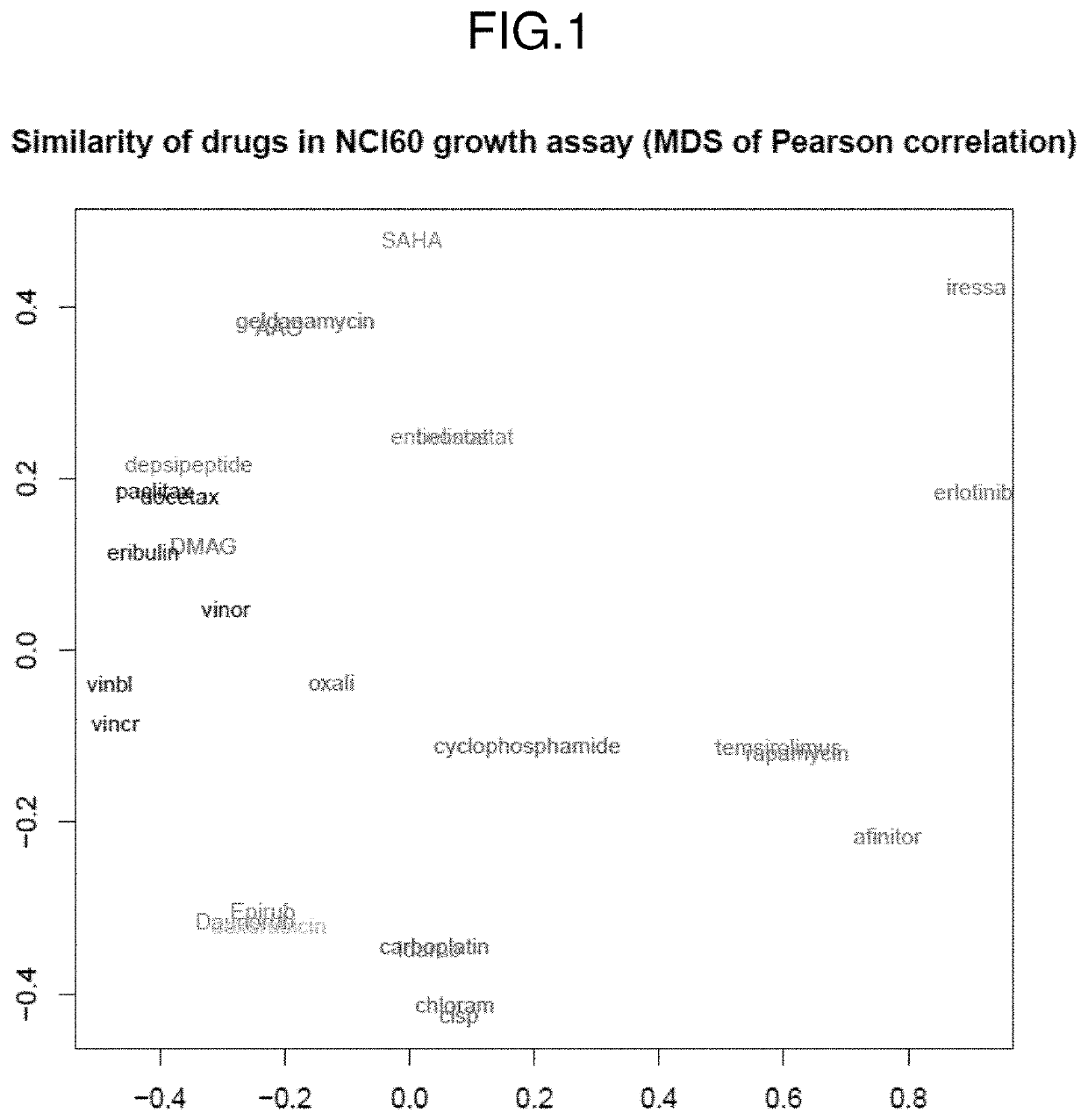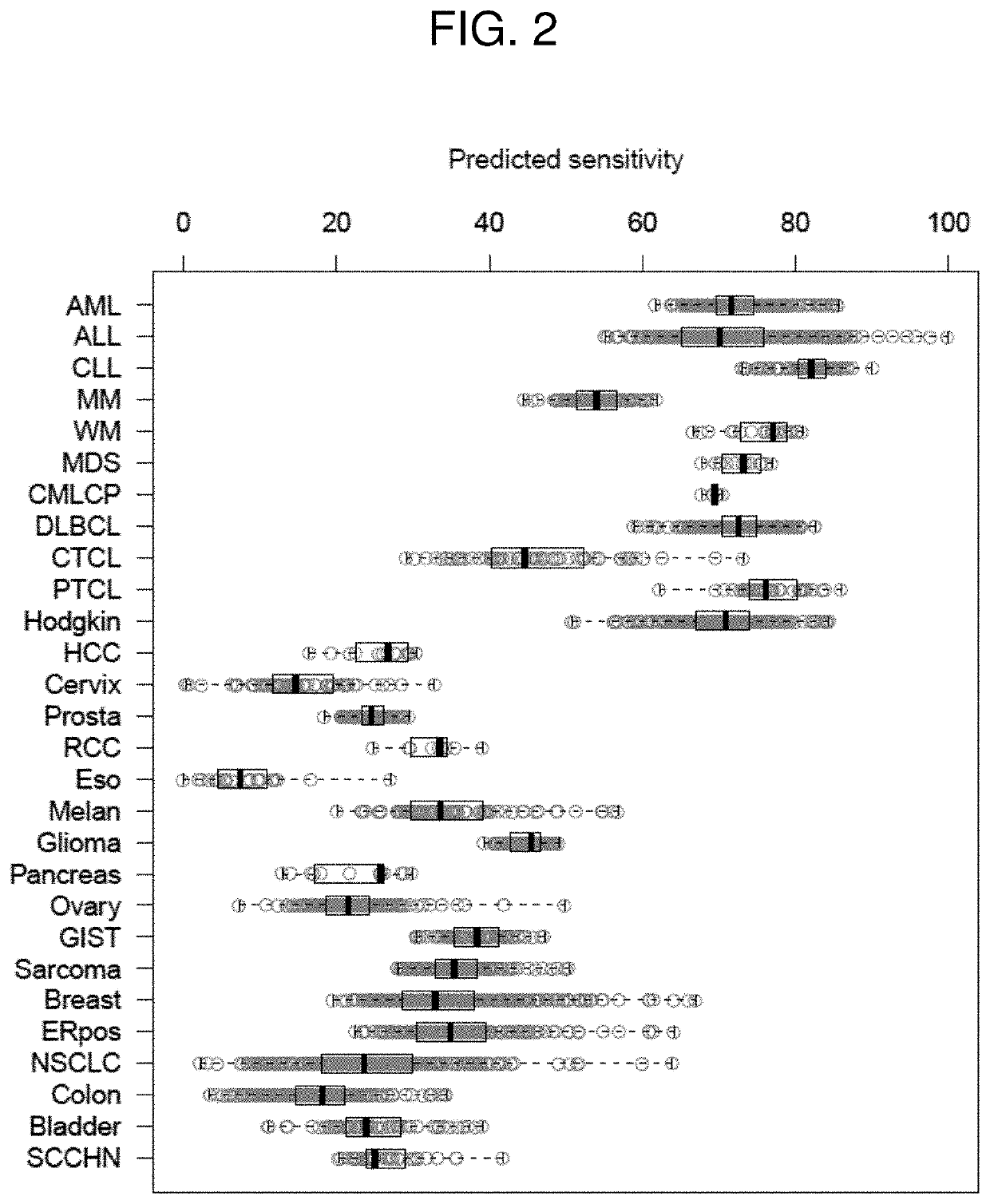Methods for predicting drug responsiveness in cancer patients
a cancer patient and drug responsiveness technology, applied in the field of cancer patient drug responsiveness prediction, can solve the problems of cancer cells often developing resistance to a previously effective therapy, often lost critical time, etc., and achieve the effects of reducing tumor mass, reducing cell growth, and reducing growth
- Summary
- Abstract
- Description
- Claims
- Application Information
AI Technical Summary
Benefits of technology
Problems solved by technology
Method used
Image
Examples
example 1
ation of Biomarkers of Sensitivity and Resistance to Doxorubicin Using Affymetrix HG-U133A Arrays
[0167]DNA chip measurements of the 60 cancer cell lines of the NCI60 data set were performed using Affymetrix HG-U133A arrays and logit normalized. For each array, the logit transformation was performed followed by a Z-transformation to mean zero and SD 1, and correlated to growth inhibition (log(GI50)). Growth inhibition data of different therapeutic agents against the same cell lines were downloaded from the National Cancer Institute. The similarity in growth inhibition profile profiles for different therapeutic agents, including doxorubicin, daunorubicin and epirubicin, and idarubicine, were determined using the NCI60 growth assay (FIG. 1). In a multidimensional scaling plot, doxorubicin, daunorubicin, and epirubicin were determined to have similar effects on the NCI60 tumor cell lines, whereas idarubicine has a slightly different effect on the NCI60 tumor cell lines.
[0168]Next, the e...
example 2
ation of Biomarkers of Sensitivity and Resistance to Epirubicin Using Affymetrix HG-U133A Arrays
[0169]DNA chip measurements of the 60 cancer cell lines of the NCI60 data set were also performed using HG-U133_Plus_2 arrays and logit normalized. For each array, the logit transformation was performed followed by a Z-transformation to mean zero and SD 1, and correlated to growth inhibition (log(GI50)). Growth inhibition data of epirubicin against the same cell lines were downloaded from the National Cancer Institute. Each gene's expression in each cell line was correlated to the growth of those cell lines (log(GI50)) in the presence of epirubicin. The covariance (Pearson correlation coefficient multiplied by standard deviation) was then determined to identify genes positively and negatively correlated to sensitivity to epirubicin. Tables 3 and 4 show the top positively correlated genes (the biomarkers of sensitivity) and negatively correlated genes (the biomarkers of resistance) using t...
example 3
g Responsiveness to Doxorubicin in Cancer Patient Populations
[0170]An mRNA-based predictor of responsiveness to doxorubicin (e.g., a doxorubicin-containing liposome 2B3-101 (DOXIL® / CAELYX®)) developed according to the methods of the invention was applied to 3,522 patients having a variety of cancers. Each patient had a pre-treatment measurement of gene expression with an Affymetrix array. The predicted doxorubicin sensitivity of each patient was calculated as the difference between the mean of the levels of the biomarkers of sensitivity (Table 1) and the mean of the levels of the biomarkers of resistance (Table 2) for the patient. When the patients were grouped by cancer types, and cancer types predicted to be more responsive to the doxorubicin were identified (FIG. 2). Of 27 different cancer types, patients with hematological cancer types were predicted to be more responsive to treatment with doxorubicin than patients with solid tumor cancers.
[0171]The median of the boxplots shown ...
PUM
| Property | Measurement | Unit |
|---|---|---|
| concentrations | aaaaa | aaaaa |
| wavelength | aaaaa | aaaaa |
| length of time | aaaaa | aaaaa |
Abstract
Description
Claims
Application Information
 Login to View More
Login to View More - R&D
- Intellectual Property
- Life Sciences
- Materials
- Tech Scout
- Unparalleled Data Quality
- Higher Quality Content
- 60% Fewer Hallucinations
Browse by: Latest US Patents, China's latest patents, Technical Efficacy Thesaurus, Application Domain, Technology Topic, Popular Technical Reports.
© 2025 PatSnap. All rights reserved.Legal|Privacy policy|Modern Slavery Act Transparency Statement|Sitemap|About US| Contact US: help@patsnap.com


